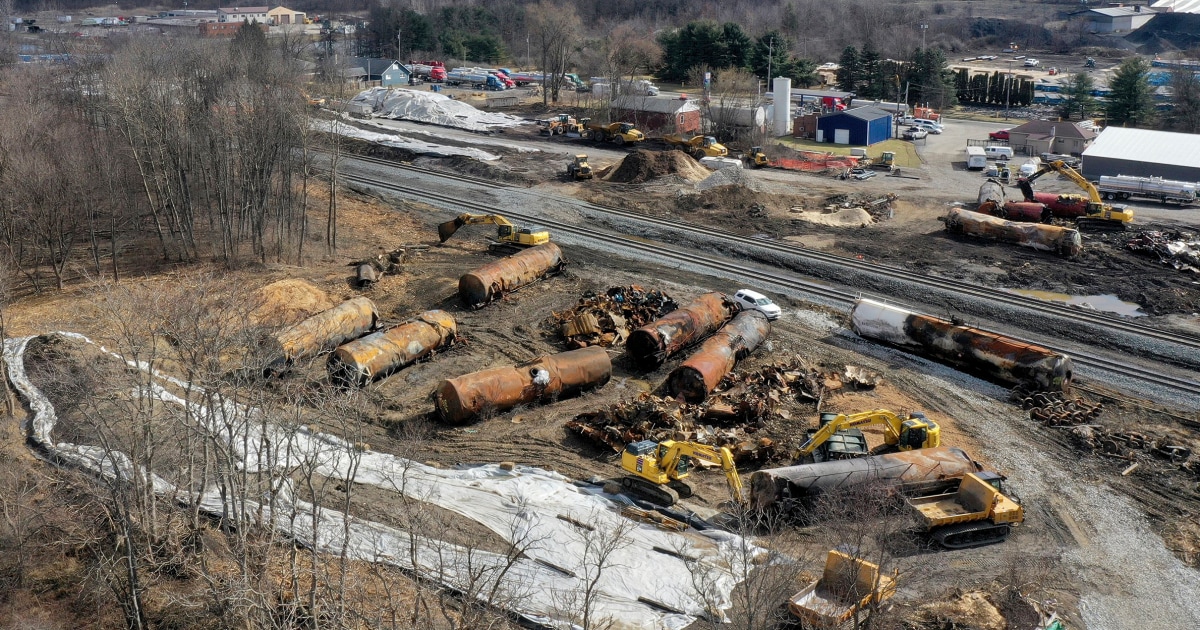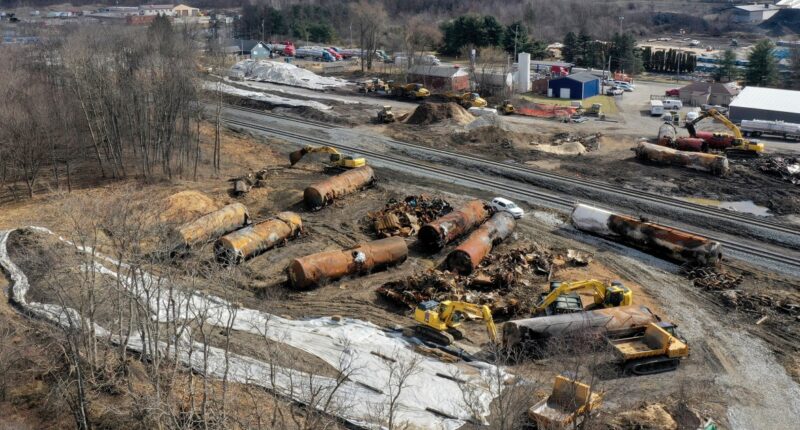
WASHINGTON — The fire and chemical spill caused by the derailment of a Norfolk Southern train in Ohio has renewed a more than decadelong battle in Washington over ways to bolster rail safety.
The cause of the derailment in East Palestine is still under investigation, with a preliminary report pointing to an overheated wheel bearing.
But as investigators search for the cause and how it could have been prevented, there has been growing speculation and finger-pointing among lawmakers and regulators. Congressional Republicans have questioned the Biden administration’s record on rail safety over the past two years while administration officials say their efforts have been hindered by industry lawsuits and corporate lobbyists.
“The future must not resemble the past when it comes to your company’s and your industry’s follow-through on support for stringent safety policies,” Transportation Secretary Pete Buttigieg said in a letter Sunday to Norfolk Southern CEO Alan Shaw. “Major derailments in the past have been followed by calls for reform — and by vigorous resistance by your industry to increased safety measures. This must change.”
Major rail accidents have spurred Congress and federal regulators into action in the past, though the efforts have had mixed results. When a commuter train and a freight train collided head-on in Los Angeles in 2008, killing 25 people, Congress mandated that a safety system called positive train control be installed more widely across the rail system.
Several derailments during the Obama administration — including one in New Jersey that released thousands of gallons of vinyl chloride, the same chemical released in the recent Ohio accident — also prompted new safety proposals, but not all were enacted.
A rule proposed in 2015 for certain trains to be updated to electronically controlled pneumatic brakes was met with fierce opposition from the railway industry, which filed a string of lawsuits citing issues they had found with the braking system and questions around the Transportation Department’s method for assessing the safety benefit.
Later that year, amid lobbying from the railway industry, Congress stepped in to require that federal regulators revamp their testing of the braking system and reissue the rule if the brakes were still found to provide benefit, slowing down the process by years. By 2018, when the rule still hadn’t been enacted, it was withdrawn by the Trump administration.
“The last time we saw a series of high-profile incidents, we took strong action and we had an avalanche of lawsuits,” said a Biden administration official in a call with reporters last week.
The American Association of Railroads, the industry’s main lobbying group, said that electronically controlled pneumatic brakes were shown in testing to have “a significant failure rate” and that the required repair time was “too long to make them practical.” The group said the failure of the brake systems could leave trains unmovable on the tracks, disrupting the flow of other cargo.
The chair of the National Transportation Safety Board, Jennifer Homendy, said in a tweet last week that the braking system requirement wouldn’t have applied to the Norfolk Southern train that derailed in Ohio because it was classified as a “mixed freight train,” not a “high hazard flammable train,” which was what the rule covered.
Biden administration officials said they will wait until the NTSB completes its investigation in Ohio before proposing new safety measures, but ultimately they believe the quickest, most effective way to improve rail safety will be through congressional action.
“The fastest way to address and get strengthened rules is for Congress to act,” said the Biden administration official on Friday. “If there’s renewed interest from Congress, we absolutely welcome it and are ready to support their efforts. A rule-making typically takes years because it requires not just coming up with a rule but opening up for public comment, completing a cost benefit analysis, and then facing those legal battles, which often drags it out even further. Congress, on the other hand, can act unilaterally and basically avoid that process.”
Members of Congress have been pointing the finger over who is to blame in Ohio, with Democrats attacking the railway industry and Republicans looking to raise questions about the Biden administration’s oversight.
“Corporations do stock buybacks, they do big dividend checks, they lay off workers — thousands of workers have been laid off from Norfolk Southern — then they don’t invest in safety rules and safety regulations, and this kind of things happens,” Sen. Sherrod Brown, D-Ohio, said Sunday on CNN.
Republicans, including Ohio Sen. JD Vance, have accused the Biden administration of trying to shift the blame to the Trump administration. Vance, along with Sen. Marco Rubio, R-Fla., have called on the Transportation Department to do more, including assessing minimum staffing levels on trains under a staffing model used by the industry called precision scheduled railroading (PSR). The senators said there were just two workers and a trainee on the 150-car train that derailed in Ohio.
“We have voiced concerns with PSR, as well as with this administration’s prioritizing of efficiency over resilience in its national infrastructure and transportation systems,” Vance and Rubio wrote. “By that token, it is not unreasonable to ask whether a crew of two rail workers, plus one trainee, is able to effectively monitor 150 cars.”
The administration is in the process of finalizing a regulation introduced last year that would require a minimum of two crew members for most railroad operations. A similar effort was made under the Trump administration in 2016, but later withdrawn with the administration stating that it was no longer necessary.
Railway operators have been cutting staff over the past decade despite an increase in the amount of freight on the railways as the industry looks to trim costs, said current and former railway officials. The pandemic accelerated the problem as workers who were furloughed when the level of freight temporarily tumbled didn’t return to their old jobs when demand snapped back.
A report last December from the Government Accountability Office found the overall number of staff among the seven largest freight railroads decreased by about 28% from 2011 through 2021, while the length of the trains has increased, adding more responsibility for fewer workers.
“Management began to find ways to cut costs, drive cash to the bottom line, and eventually about 30% of the staff top to bottom had been laid off,” said a former railway safety official during the Bush and Obama administrations who spoke on the condition of anonymity to offer a frank assessment. “Then 2020 happened and the great resignation people didn’t come back when traffic came back. The industry found themselves truly in a difficult situation. They tried to staff back up, but in most cases, that’s easier said than done.”
The American Association of Railroads says it is urging the public to wait until the completion of the NTSB investigation before drawing conclusions.
“As the NTSB’s work continues, any speculation as to the cause or contributing factors that lead to the incident is just that — speculation — and undermines the overall fact-gathering process,” the industry group said in a statement. “Additionally, immediate pushes for legislative or regulatory action absent of NTSB results and in response to the accident is premature at best — and opportunistic at worst.”
The group said that 99.9% of all hazmat shipments reach their destination without incident and that the hazmat accident rate has declined by 55% since 2012.
Aside from congressional action or new federal rules, administration officials said they are also hoping some of the $550 billion from the infrastructure law passed in 2021 will help with overall safety improvements to the railways. The law includes $4 billion in discretionary funds to improve rail safety and train crossings.
The Biden administration will also issue any civil fines to Norfolk Southern if the NTSB investigation reveals any laws were broken, Buttigieg said.
“I want to make certain that you are aware that the U.S. Department of Transportation’s (USDOT) Federal Railroad Administration (FRA) is conducting its own analysis to determine whether any safety violations occurred,” he said in the letter to Norfolk Southern. “Using this analysis and after receiving the findings from the NTSB’s independent work, FRA will act with all of its legal authorities to hold Norfolk Southern responsible for any safety violations found to have contributed to this derailment.”
Source: | This article originally belongs to Nbcnews.com










